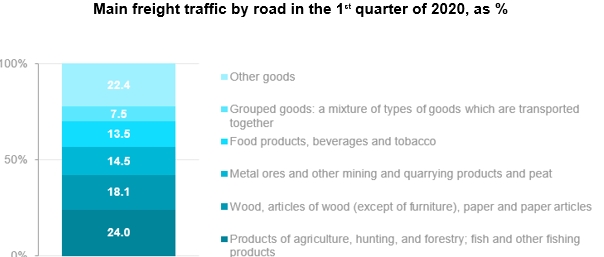Analytics, Energy, Latvia, Oil, Transport
International Internet Magazine. Baltic States news & analytics
Sunday, 21.12.2025, 07:22
In Q1, freight transport by road reduced by 1.3% in Latvia
 Print version
Print versionThe freight carried by road comprised 14.5 million tons, which is 0.2 million tons or 1.3% less than in the 1st quarter of 2019.
10.2 million tons of national freights were carried, an increase of 0.6 million tons or 6.2% as compared the 1st quarter of the previous year. International freights accounted for 4.3 million tons – 0.8 million tons or 15.3% less. Of which export freight transport comprised 0.9 million tons – 22.7% less. Import freight transport fell by 17.1% and comprised 0.8 million tons of freight. In the 1st quarter of 2020 cabotage and cross-trade freights comprised 2.6 million tons, which is 11.7% less than in the 1st quarter of 2019.

24% of total freights carried in transport by road were made up by products of agriculture, hunting, and forestry; fish and other fishing products, transport of which rose by 20.6%. Wood, articles of wood (except of furniture), paper and paper articles comprised 18.1% of total freights carried, their transport reduced by 6.3%. 14.5% were comprised by metal ores and other mining and quarrying products and peat (rise of 7.8%), but 13.5% – by food products, beverages and tobacco. Transport of mail and parcels and machinery, equipment and office machinery increased more than twice: by 182.3% and 104.4%, respectively.
Transportation by main oil products pipeline continues to decrease
In the 1st quarter of 2020, 0.5 million tons of oil products were transported by main oil products pipeline, which is a drop of 44.6%than in the 1st quarter of 2019.
Downturn in number of passengers carried by land passenger transport
During the 1st quarter of 2020, the number of passengers carried by land passenger transport comprised 51.7 million passengers, which is 13.2% less than in the 1st quarter of 2019. Reduction in the number of passengers was affected by declaration of emergency situation in the country due to Covid-19 pandemic and consequential restrictions in transportation.
The number of passengers carried by rail transport comprised 3.8 million, a drop of 7.8%. Number of passengers carried by national transport reduced by 7.6%, but the number of passengers carried by international transport reduced – by 37.7%.
29.3 million passengers were carried by regular domestic bus traffic lines, which is 16% less than a year ago. Number of passengers carried in national lines reduced by 15.9%, but the number of passengers carried in international lines reduced – by 31.1%.
The number of passengers carried by urban electrified transport comprised 18.6 million passengers, a drop of 9.7%.
Passengers carried by land passenger transport (million passengers)
|
|
1st quarter
of 2018 |
changes as %, compared to the 1st quarter of 2017 |
1st quarter
of 2019 |
changes as %, compared to the 1st quarter of 2018 |
1st quarter
of 2020 |
changes as %, compared to the 1st quarter of 2019 |
|
Total |
59.0 |
-2.2 |
59.6 |
1.0 |
51.7 |
-13.2 |
|
Rail |
3.9 |
0.2 |
4.1 |
4.3 |
3.8 |
-7.8 |
|
Regular bus traffic lines |
34.0 |
-2.7 |
34.8 |
2.4 |
29.3 |
-16.0 |
|
Trolleybuses |
10.5 |
-5.0 |
10.2 |
-2.6 |
10.1 |
-0.9 |
|
Trams |
10.6 |
1.8 |
10.5 |
-1.3 |
8.5 |
-18.4 |
More information on transport statistics in Latvia is available in the CSB website in section “Transport – key indicators”. The latest data on transport will be published in database section „Transport and Tourism” (short-term statistics data and annual statistics data).
- 28.01.2022 BONO aims at a billion!
- 25.01.2021 Как банкиры 90-х делили «золотую милю» в Юрмале
- 30.12.2020 Накануне 25-летия Балтийский курс/The Baltic Course уходит с рынка деловых СМИ
- 30.12.2020 On the verge of its 25th anniversary, The Baltic Course leaves business media market
- 30.12.2020 Business Education Plus предлагает анонсы бизнес-обучений в январе-феврале 2021 года
- 30.12.2020 Hotels showing strong interest in providing self-isolation service
- 29.12.2020 В Латвии вводят комендантский час, ЧС продлена до 7 февраля
- 29.12.2020 В Rietumu и в этот раз создали особые праздничные открытки и календари 2021
- 29.12.2020 Latvia to impose curfew, state of emergency to be extended until February 7
- 29.12.2020 Linde Gas открывает завод в Кедайняйской СЭЗ








 «The Baltic Course» Is Sold and Stays in Business!
«The Baltic Course» Is Sold and Stays in Business!

